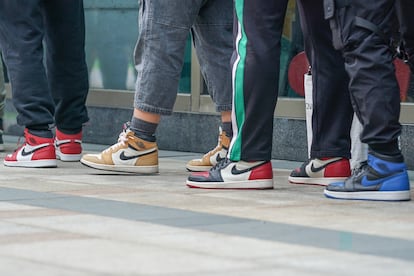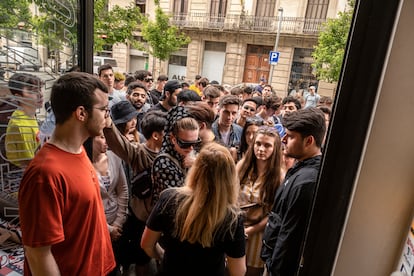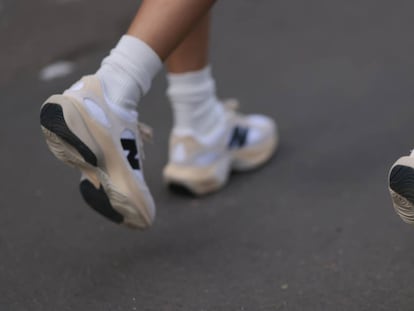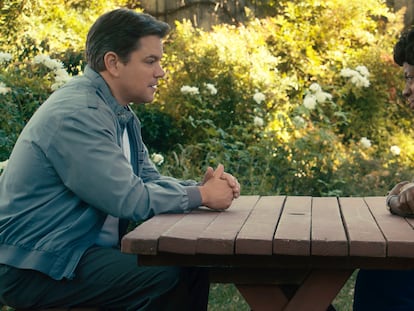‘Spending $850 on sneakers was unsustainable’: Has the sneaker bubble finally burst?
The fever for overpriced sports footwear has subsided. Buyers are moving away from the most iconic models and, although sales have not dwindled, the second-hand market has begun to deflate

February 23, 2012. More than a thousand people were standing in line at the doors of a mall in Orlando, Florida. The reason was not a record signing by a pop star or a visit from a Hollywood actor, but something more prosaic in principle: sneakers. To be precise, back then, the Nike LeBron 9 Foamposite “Galaxy” were the latest model in the American sports firm and NBA star LeBron James’s line, in a limited edition with a sole that glowed in the dark. The 200 pairs that had been delivered to the store were going to go on sale at 9:00 p.m. as part of the celebration of the NBA All Star weekend, but something changed the plans.
The sneakerheads waiting to get their hands on the desired model had been instructed to wait on the sidewalk in front of the mall, but one of them decided to ignore that request and stood at the door. Faced with the possibility of someone cutting in ahead of them, the crowd surged forward in search of the next closest spot. The throng was so rowdy that the local police had to intervene, sending officers on horseback and a helicopter to disperse the crowd.
That event is considered the unofficial start date of sneaker fever. That is, the collection of rare or limited pieces of sports footwear that could reach stratospheric prices on resale. Eleven years later and after the rise of streetwear culture, which has been increasingly linked to the world of luxury through collaborations between brands, sneakers have gone from being a cult collector’s item to a garment with mass audience appeal. As in almost everything, the blame can be attributed to social media.
Samba for everyone
The influential online magazine and website Business of Fashion has described how, in 2023, the world of sneakers has experienced not a crisis, but a small blip that has made it rethink its strategies. According to the data provided by Daniel Yaw-Miller’s article, giants such as Nike and Adidas have been seen, for the first time in years, to have excess inventory and have experienced a drop in sales in markets such as China. Meanwhile, less massive brands such as On, Salomon, and Asics have gained a share of the market by winning over buyers who were fed up with brands that rely too heavily on collaborations with popular figures, which, in cases like Kanye West, have turned out to be a flop.
This does not mean that the consumption of branded sneakers is in crisis, but it is changing. “I think that right now is the time when sneakers are being bought the most. You see kids on the street wearing Jordan 1 or Jordan 5, and even among the top sneakers you see fakes,” explains Ernesto Cabeza, a sneaker collector. “What is happening is that now the resale market has deflated. Before, you knew that you were going to get between $215 and $320 in profit for some models of Jordan 1 or Jordan 5, and now you probably won’t get anything.”

Therefore, the world of sneakers has become massive. “The other day on my daughter’s birthday, an 11-year-old boy asked me if I had a pair of Travis Scott 1s,” adds Cabeza, in relation to one of the models from Nike’s collaboration with the rap artist. “Even my mother tells me that she watches videos of collectors and people unboxing sneakers on social media.” Brands have also contributed to this expansion among the general public. “What they have done for years is put very few units of a specific product on sale so that that expectation is generated and everyone wants them. When they get that demand, they flood the market and raise the price,” adds Tany.
David Camprubi, CEO and founder of NewCop, a company specialized in sports shoes that are difficult to find in the regular market, says that sneakers have become an urban status symbol that is increasingly encompassing a wider audience. “We created our company in 2022 because we realized that many of these shoes could only be found online, meaning you couldn’t even try them on before buying them.” They now have two physical stores in Barcelona and another in Madrid. “Sneakers have gone from being something esoteric to becoming the norm. If you go to a school now, you will see all the kids with some of the models we sell in our stores. The age range has also expanded. A couple of years ago only young people bought [sneakers from us], and now we see people over 40 years old. Without going any further, I recently gave my father a pair of Nike Dunk Panda and he loves wearing them.”
Yeezy, the genesis
The incident in Orlando with the Nike LeBron 9 Foamposite “Galaxy” was the one that sparked sneaker fever among the youth, but it was not the first. In 2005, the collaboration between Nike and designer Jeff Staple caused an altercation in the Lower East Side of New York resulting in several arrests. The model, the Nike Dunk Low SB “Pigeon,” would become one of the most legendary and sought after by every sneaker collector, but also by resellers. Over time, the price of that model on the secondary market has exceeded $30,000.
The fever for sneakers has spread from the United States to the entire world. The big sports brands, always attentive to what was happening on the streets, saw a more effective strategy than any marketing campaign. They put a certain product on sale in such limited quantities that they immediately became an object of desire, and also of conversation.
In Spain, the first generation of collectors has witnessed this boom, from being a circle for initiates to becoming a growing phenomenon. “I had always liked sneakers. I would buy some and end up selling them, or I would buy two pairs and keep only one, which worked out cheaper,” explains Tany, a veteran of the sneaker scene. “But in 2016 the boom started, and a lot of young people who wanted to make quick money emerged, and reselling sneakers was an easy way to do it. Then you started to see that there were lines on launch days at stores, that there were people who paid other people to wait in line for an entire night and that the sneakers were resold for more money on the spot, right after buying them,” he says.
That time marked the beginning of the sneaker fever in Spain, and its most obvious trace could be found on the streets: lines of people, who sometimes camped outside the doors of certain stores for several days, waiting for a particular model to go on sale. An image that was not benevolent for the brands, which ended up restricting the sale of their limited editions to the internet. But, once again, the collectors found a work-around: resale experts began to use bots to flood purchase requests from the big brands’ websites and apps, and thus gain access to purchase a greater number of pairs that were then resold at a higher price.
The growth of that bubble was largely influenced by the association of different figures in the music and fashion industries with brands. “When Kanye West released the Yeezys with Adidas, there was a new hit, which made many more people get into reselling,” Tany remembers. “He was an artist with a very high number of followers, and had already had a hype with Nike. When he started working with Adidas, they started reselling Yeezys for a fortune. The first model he released sold for about $375 and on resale it could reach $1,600.” According to data from the Statista platform, the global sneaker market went from $53 billion in 2016 to $72 billion in 2022.
Exclusive, but not insane
The feeling of exclusivity, therefore, has changed in the sneaker world, but it has by no means died. “What was not sustainable or good for anyone is that, to get a certain model, you had to spend $850, which is something that very few people can do,” Camprubi concludes. From these figures, the trend has moved on to other less stratospheric ones: “Now there is a lot of demand for Adidas Samba and Gazelle, because many influencers wear them, and which you can buy for about $215” [this refers to special editions that can be found in NewCop, not the originals, which are available from about $130]. What has been ominous for the resale underworld has benefited businesses like Camprubi’s. “This change has been bad for collectors, but it allows us to sell to a larger audience,” he concludes.
Sign up for our weekly newsletter to get more English-language news coverage from EL PAÍS USA Edition
Tu suscripción se está usando en otro dispositivo
¿Quieres añadir otro usuario a tu suscripción?
Si continúas leyendo en este dispositivo, no se podrá leer en el otro.
FlechaTu suscripción se está usando en otro dispositivo y solo puedes acceder a EL PAÍS desde un dispositivo a la vez.
Si quieres compartir tu cuenta, cambia tu suscripción a la modalidad Premium, así podrás añadir otro usuario. Cada uno accederá con su propia cuenta de email, lo que os permitirá personalizar vuestra experiencia en EL PAÍS.
¿Tienes una suscripción de empresa? Accede aquí para contratar más cuentas.
En el caso de no saber quién está usando tu cuenta, te recomendamos cambiar tu contraseña aquí.
Si decides continuar compartiendo tu cuenta, este mensaje se mostrará en tu dispositivo y en el de la otra persona que está usando tu cuenta de forma indefinida, afectando a tu experiencia de lectura. Puedes consultar aquí los términos y condiciones de la suscripción digital.
More information
Archived In
Últimas noticias
Most viewed
- Reinhard Genzel, Nobel laureate in physics: ‘One-minute videos will never give you the truth’
- Oona Chaplin: ‘I told James Cameron that I was living in a treehouse and starting a permaculture project with a friend’
- Pablo Escobar’s hippos: A serious environmental problem, 40 years on
- Charles Dubouloz, mountaineering star, retires at 36 with a farewell tour inspired by Walter Bonatti
- Why we lost the habit of sleeping in two segments and how that changed our sense of time










































